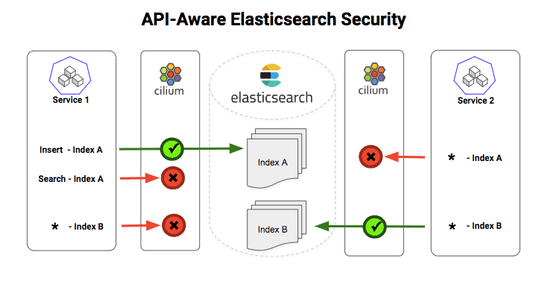Analyzing the CNI performance benchmark
This blog post documents the investigation we have done so far of what looked like a performance regression of HTTP/FTP traffic over pure TCP.
This blog post documents the investigation we have done so far of what looked like a performance regression of HTTP/FTP traffic over pure TCP.
Cilium provides API-aware network security for cloud-native applications. Here's a How-To guide to get you going easily with Kubernetes and Cilium on Ubuntu 18.04 LTS.
In Kubernetes deployments, Prometheus is a popular monitoring system and time-series database for storing health and performance metrics of all the components. Equally popular is Grafana for plotting the metrics. In this post, we will provide steps to setup Prometheus and Grafana for understanding important Cilium metrics related to the security and health of service interactions in a Kubernetes cluster.
Elasticsearch is a dominanting open source platform for storing and analyzing all different types of data ranging from application logs, to user payment transactions and network audit logs.
As we approach the upcoming 1.0 release, the Cilium community has been putting a lot of effort towards monitoring and troubleshooting. This has led to the development of several new tools in the project which we'll explore in this blog series. In this first part, we will cover **cilium-health**, a tool for troubleshooting intra-cluster connectivity issues.`
This blog post focuses on Layer 7 (HTTP) policy rules and how to apply them for both outgoing and incoming connections in the context of a Kubernetes cluster using a ThirdPartyResource. This is a first step in integrating L7 policies into the Kubernetes world, next steps will involve integration with Istio and the Envoy proxy. We will talk about our plans and the details how Cilium empowers both of them in one of the next blog posts.
In celebration of today's date, May 4th, we are posting our Star Wars demo of Cilium that we showed at CNCF/KubeCon in Berlin or DockerCon in Austin. You can either watch the video linked below which starts directly at the time the demo begins or you can jump to the transcript of the demo embedded in the blog post. May the fourth be with you.
A while ago we started thinking about how to build a continous integration (CI) testing infrastructure that would help us maintain the reliability and stability of Cilium as we add more features and integrate with orchestration systems like Kubernetes and Docker. This post describes our process for building a CI environment capable of testing a container networking & security infrastructure.
For live conversation and quick questions, join the Cilium Slack workspace. Don’t forget to say hi!
Join slack workspace

